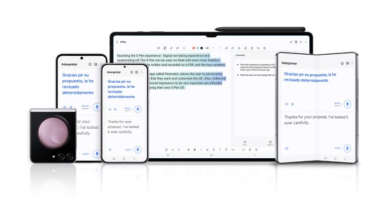Apple’s Journal app has arrived – here’s what’s good and bad
Having used Journal for a few days now, I feel confident saying that Day One is not staring down an existential threat — at least not yet. Keep in mind we’re talking about Apple has a well-known history of Sherlocking new apps with feature updates (it was, after all, the company that gave rise to the term), but in its current form, the new journaling app still has a ways to go to catch up with Day One’s head start.
After all, the Automattic-owned app has been kicking for more than a decade, at this point. It’s worth mentioning here that Apple’s long been a fan of their work, naming it “Mac App of the Year” in 2014 and giving it an Apple Design Award two years later.
“Rather than seeing this as competition, we embrace Apple’s entry into digital journaling as a testament to its growing importance,” Paul Mayne, head of Day One told TechCrunch. “This evolution is not just beneficial for Day One, but also for our valued users.”
It’s the rising tide approach to facing down a juggernaut. I think it’s safe to say that Apple entering your small slice of the App Store is a kind of validation of your mission. Day One has a pretty loyal fanbase, from what I gather, and switching over to another app entirely may be more trouble than it’s worth. We’ll have to reassess the situation when Journal has a wider feature set and is (hopefully) available on more platforms.

Image Credits: Apple
Day One’s cross-device functionality/syncing has been a big selling point for me — I paid for the premium version for precisely that reason. When Apple announced Journal at WWDC, I was excited to check it out. After all, Apple is the ecosystem company. Surely the company would prioritize the creation of an app that works on macOS and iPadOS, along with iOS.
I’m not saying “never.” In fact, I’m not even saying “definitely not next year.” But as I write this, the company has expressed no plan to offer the app on other first-party platforms, in spite of all the work it has done in recent years to remove the friction that comes with porting an iOS app to macOS. At the moment, Apple’s stance is that iOS is the best possible way to experience the app.
In the meantime, the closet it comes to cross-device syncing is its support of iCloud backups.
I believe that’s very much rooted in the way that content is centered. Journal is very much being positioned as a multi-media app. The concept is to go beyond the standard text journal by fully harnessing the power of digital. There’s little question that the iPhone is a more flexible content capture device than the Mac. That means photos, videos and voice recordings. It’s also a device tied to (opt-in) location-based services, which plays a factor here.
As you’ve likely gathered from my 7.5 years at TechCrunch, I’m a writer. And unlike a lot of people who have been doing what I do for a long time, I still love it. After I punch the clock for the day or weekend, I keep doing it. For some reason, I was initially hesitant about journaling. I don’t know. Too much earnestness feels corny to me. I also came up as a blogger, so the instant gratification of writing for an audience is now woven into my DNA.
Once I forced myself to do it, however, of course I liked it. It’s unencumbered writing. And it’s writing entirely about oneself in a way I never had before. As a writer, it’s probably obvious that writing is the best way for me to process my experiences. It was a handy tool during the pandemic and a great resource for someone with an admittedly terrible memory.

Image Credits: Apple
Being a writer, however, means I tend to write long — just spilling my thoughts onto the paper. For me, the most difficult aspect of journaling is the tacit acknowledgement that it’s impossible to get all of your thoughts down at the same time. But I find getting my thoughts down to be a much more frictionless process while using a laptop. With Apple’s vision for Journal, however, text is almost secondary to photos, videos and text.
Obviously, images and video are great for evoking visceral memories, but writing through things at the end of a long day is a great way to process the last 24 hours. And sitting down in front of a laptop is a great way to give that processing the attention it deserves.
Suggestions are the real secret sauce here. Apple is looking to differentiate itself by offering writing prompts based on algorithmically curated moments that span the company’s ecosystem, including photos, workouts and other media. The company says the opt-in feature will improve the more you use the app, though honestly, I don’t think I’ve been using the app for long enough to really get that algorithmic boost.
It’s a nice feature for those who struggle to fill up a virtual notebook every day. My suspicion is that Apple came up with the idea of content-driven prompts and then built a journaling app around it. In fact, the company has already opened up an API that lets competitors access the aforementioned secret sauce. It’s an interesting and novel play for Apple, but perhaps it will further slow future Sherlocking in the category. I’m generally of the opinion that more competition = good.

Image Credits: Apple
There are some nice security touches. For one, the app can be looked at with a code, so someone who has access to your phone can’t read those personal musings.
The app will almost certainly be compared to more established journaling offerings for a while. Journal is a bit barebones when compared to the veterans. Depending on your preference, that can either be a negative or positive. Some will almost certainly love its simplicity. Others will lament its lack of customization options, folders and tags. Voice recordings, meanwhile, don’t save as transcriptions.
There’s also a lot of opportunity for deeper integration with the existing ecosystem. How about the new mood logging feature tied to Apple’s new mental health offerings? Much like that feature, Journal can be set up to send you notifications when new suggestions pop up. Tying the two together seems like a no-brainer.
Keep in mind, we’re still early in this. Heck, it’s still only available as part of iOS 17.2’s public beta. There’s a lot of room for growth here, and journalers tend to be a passionate variety, so Apple will almost certainly be getting a lot of feedback, including from me, as I shout from the rooftops for a Mac version.




